



Next: Beam
Up: The NA44 Experiment
Previous: The NA44 Experiment
Contents
Kopytine's homepage
In the design of fixed target heavy ion experiments, one can distinguish two
opposite stratagems:
- Emphasize quality of a given set of measurements (resolution, cleanliness
of particle identification).
Sacrifice broadness of scope in order to fully concentrate on the selected
measurements.
- Emphasize broadness of scope (acceptance, variety of identifiable
particles).
Sacrifice quality of measurements (resolution, quality of particle
identification).
A clear awareness of one's stratagem, readiness
to counteract its drawbacks and
fully utilize its strengths is an essential prerequisite of success.
The choice of a stratagem (or, in a mixed case, choice of a proportion of the
mix) is driven by the experiment's goals.
The goals of the NA44 Experiment have been:
- Hanbury-Brown-Twiss (for short, HBT) interferometry[25]
with pions, kaons
and protons, reaching a formulation as complex as 3D.
- Single particle spectra of pions, kaons, protons, antiprotons, deuterons,
antideuterons, and even tritons.
In particular, a study of low
 features of the spectra around
midrapidity.
features of the spectra around
midrapidity.
- Measurements of the abundances of the above mentioned particles.
Thus ordered, the goals entail the design concept of an experiment,
which follows the first stratagem: a focusing spectrometer.
Focusing magnetic field provides for excellent momentum resolution,
but can be effective only in a narrow region of phase space.
Hence the smallness of track multiplicity that enables clean particle
identification using the relatively simple techniques based on
time-of-flight and Cherenkov radiation.
Figure 3.1:
The NA44 spectrometer during the Pb beam running.
The T0 and the Si pad array are in the target area and are too small
to be seen on this scale. The target area is shown in Fig. 3.2
 |




Next: Beam
Up: The NA44 Experiment
Previous: The NA44 Experiment
Contents
Mikhail Kopytine
2001-08-09
